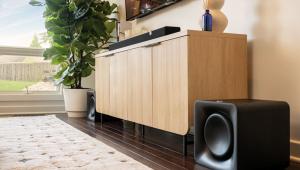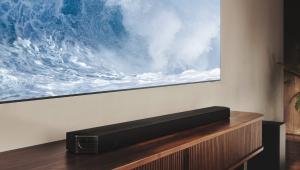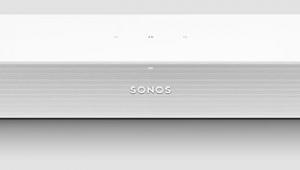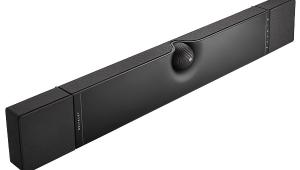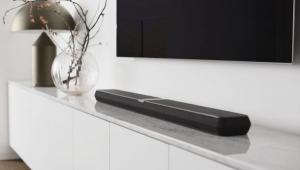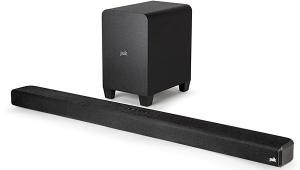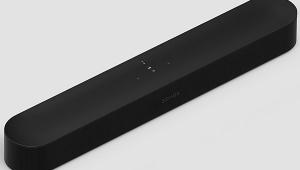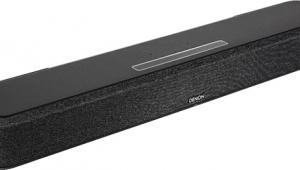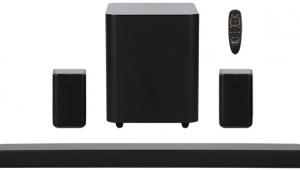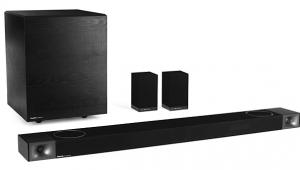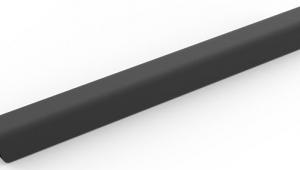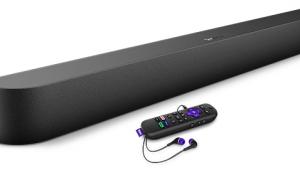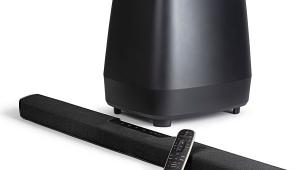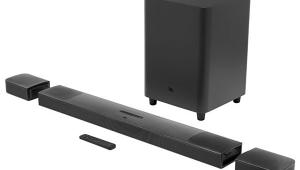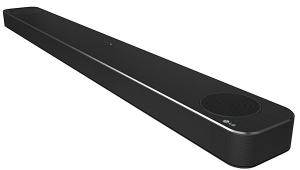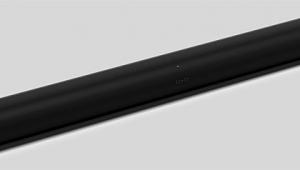This soundbar downgrades DTS to 2.0, a major con. This is a surprising omission in this review.
Samsung HW-K950 Soundbar System Review Page 2
Listening
I usually like to start off a surround system evaluation by listening to stereo music in 2.1-channel mode. Just as getting a perfect picture from a TV begins with a properly adjusted blackand-white image, you can’t get good surround performance from a system unless it’s already working well in stereo.
The self-titled album by D-Stringz is a recent collaboration between jazz violin legend Jean-Luc Ponty, bass virtuoso Stanley Clarke, and French gypsy/swing guitarist Biréli Lagrène. On a cover of John Coltrane’s “Blue Train,” the three players stretch out and jam, with Clarke playing an acoustic bass instead of his more familiar slap-style piccolo electric. I found that with the subwoofer at the default setting, there was a little too much weight in the bass for my room, so I clicked it back a couple of notches, allowing the sub to kick out some pretty powerful and tuneful stuff in the lower octaves. Both Ponty’s violin and Lagrène’s guitar had a satisfyingly rich and detailed sound, with none of the brittle thinness you often get from typical soundbars.
With only about 4 feet separating the left and right channels in the soundbar, the HW-K950 can’t quite deliver the type of big threedimensional soundstage you can get from individual speakers spaced several more feet apart. But on “Take Five” from the Dave Brubeck Quartet’s Time Out, the Samsung did an admirable job of projecting the huge drum sound out beyond the confines of its box. Brubeck’s piano came across with a fine sense of harmonic color, while Paul Desmond’s sax had a good balance of breathiness and just the right amount of raspiness and bite.
Of course, the HW-K950’s claim to fame is its simple approach to bringing Dolby Atmos to the party, so the $64,000 question was: Could a soundbar and some wireless surround speakers do an effective job of delivering the height dimension from suitably encoded movies?
In Mad Max: Fury Road, there’s a scene where Max is alone in the desert, hearing whispered voices in his head, and those voices are mixed with a variety of other sounds. With the Atmos channels engaged, the soundtrack filled my room in all directions, giving the effect of being inside Max’s head. Meanwhile, the narrator’s voice has a short slap echo, which lends it a thick, resonant quality. And on top of everything, some really dynamic sound effects slash around the action, with the deep rumble of a car engine filling out the bottom end. Despite these challenges, the HW-K950 took it all in stride, delivering whip-crack dynamics and a truly immersive soundstage. A good test of whether a system can handle the dynamics of an intense movie is revealed in your own reaction to the sound: Do you want to keep cranking it up? Or do you start to get tense and feel an urge to dive for the volume-down button? With the Samsung, I inevitably wanted to crank it up—and even with high peak levels, it didn’t seem like the system was being stressed.

A scene from Jupiter Ascending confirmed how skillfully this soundbar has been voiced, as it allowed the richness of Michael Giacchino’s orchestral score to underpin the action. Gunshots and body blows had a slam that belied the fact that I was listening to a bunch of 2.5-inch drivers, and the blend over to the sub was nearly impossible to pinpoint. The four height drivers really did work to expand the sense of space, delivering a more immersive experience.
Conclusion
As a hard-core home theater enthusiast, I have often lamented the market shift over to soundbars and away from genuine multiple-speaker surround systems using a receiver. But having experienced what can be achieved when a soundbar is done properly, I totally get it. For the price of the Samsung HW-K950, you could instead get a pretty decent receiver-and-loudspeaker package, but I can’t guarantee that it would work better for you. What you get with the Samsung is a system that’s easy to set up and use—and one that sounds clear, powerful, dynamic, and transparent. What you give up is the ability to pick and choose individual speakers and components, a degree of flexibility for really complex rigs, and a little bit of soundstage dimensionality across the front channels. I’m sure this is a trade-off that many would be happy to make in the name of simplicity.
- Log in or register to post comments

